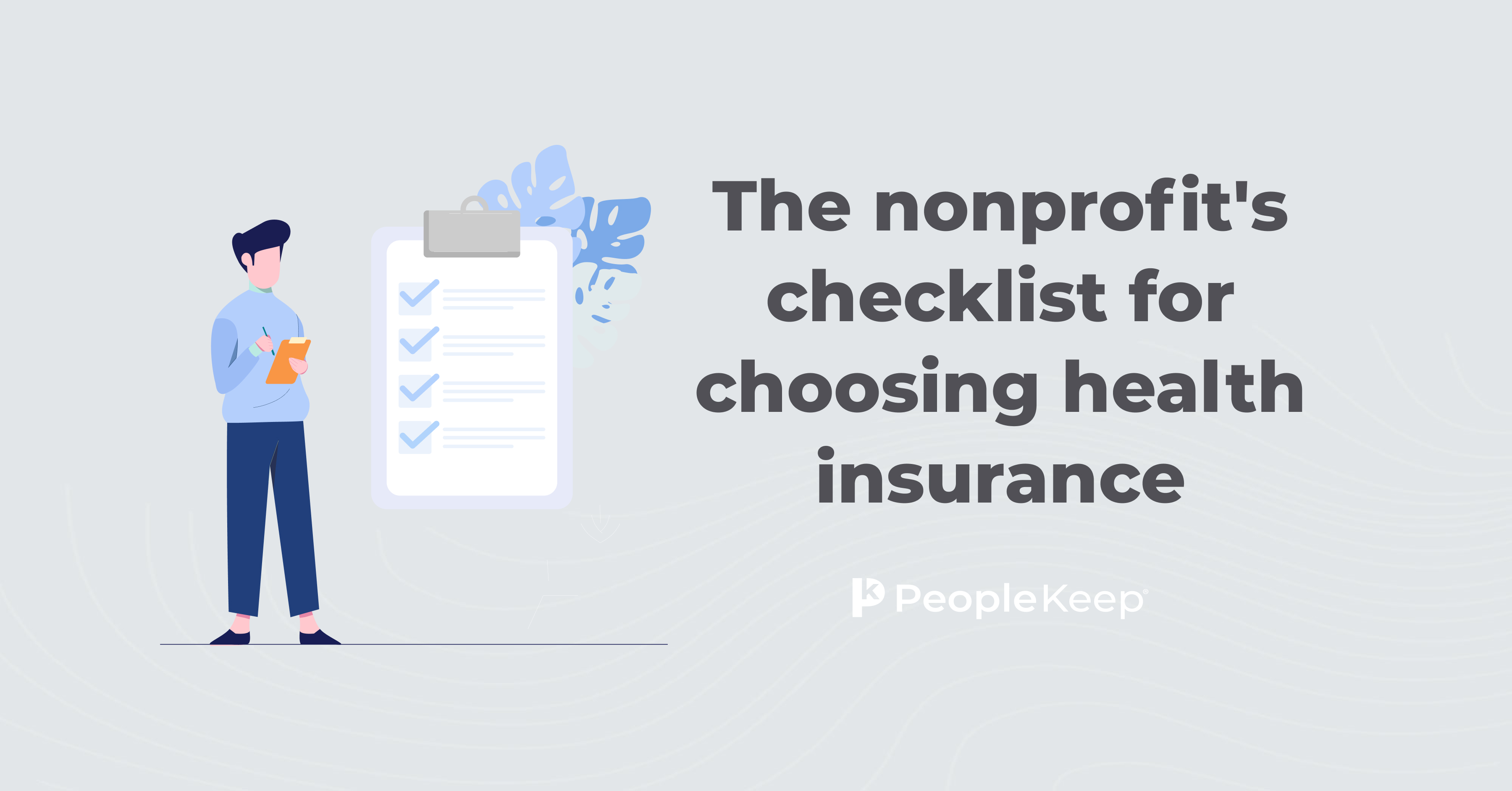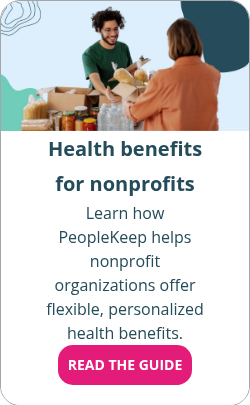How nonprofits can offer health insurance
By Elizabeth Walker on March 7, 2025 at 8:00 AM
Rising healthcare costs make it difficult for many small employers to offer quality health benefits. This can be especially true for nonprofit organizations. With limited resources and budgets, finding an affordable way to support your employees can feel like an uphill battle.
According to KFF, the average annual premium for group health insurance in 2024 was $8,951 for self-only coverage and $25,572 for family plans1. Once you add in the participation requirements and yearly rate hikes, many nonprofits may not see traditional group coverage as a viable option.
Luckily, there are alternatives to group health insurance that can help nonprofits offer affordable health benefits. So, what health benefit options are available for nonprofit organizations? Let’s explore your choices.
In this blog post, you’ll learn:
- The different health insurance options that are available to nonprofit organizations.
- How health reimbursement arrangements (HRAs) provide flexible, comprehensive coverage.
- How health stipends compare to HRAs for nonprofit employers.
What health insurance benefits are available to nonprofit organizations?
There are various ways nonprofit organizations can offer health benefits. Small group health insurance is a plan option. But, many small businesses and nonprofits find it challenging to provide. This is often due to its cost, eligibility requirements, and one-size-fits-all model.
Employers can also establish self-funded group plans. However, since the business is responsible for paying employees’ medical claims, the risk is often too great for small businesses and nonprofits.
Popular alternatives to group plans include health reimbursement arrangements (HRAs) and health stipends. We’ll cover these options in-depth in the sections below.
What is a health reimbursement arrangement (HRA)?
An HRA is an IRS-approved, employer-funded health benefit that reimburses employees for qualifying out-of-pocket medical costs. With a stand-alone HRA, individual health insurance premiums are eligible expenses. Many businesses use HRAs over group medical coverage because of the greater flexibility and budget control that HRAs offer.
With an HRA, organizations set a monthly allowance for employees to use. After purchasing an eligible item or service, employees submit documentation to their employer for approval. After you review the claim, you'll reimburse them tax-free up to their allowance amount.
Each HRA has its own features and requirements. But, three popular types of HRAs offer the most promise to nonprofits.
Qualified small employer HRA (QSEHRA)
The first is the qualified small employer HRA (QSEHRA). A QSEHRA is for organizations with fewer than 50 full-time equivalent employees (FTEs). You can offer a QSEHRA as long as you have at least one W-2 nonprofit employee.
You can design the benefit to reimburse employees for premiums only or premiums plus other medical costs. While there are no minimum contribution caps, the IRS does set annual limits.
All QSEHRA reimbursements are free of payroll tax for employers and employees. Reimbursements are also income-tax-free for employees. Employees need a health plan with minimum essential coverage (MEC) to participate.
Individual coverage HRA (ICHRA)
Next, there’s the individual coverage HRA (ICHRA). Like the QSEHRA, nonprofits can use the ICHRA to reimburse employees tax-free for individual health insurance premiums and other medical expenses.
ICHRAs are newer and more flexible for organizations than QSEHRAs and are growing in popularity. The HRA Council found that ICHRA adoption among U.S. employers rose 29% from 2023 to 20242.
Here are some other key points about the ICHRA:
- All employers with at least one W-2 employee can offer an ICHRA. This includes businesses, nonprofits, government entities, and religious organizations.
- Unlike a QSEHRA, the ICHRA is available to organizations of all sizes. Additionally, it has no maximum contribution limits.
- Applicable large employers (ALEs) can use the ICHRA to satisfy the Affordable Care Act (ACA) employer mandate. To comply with the ACA, your benefit must be affordable.
- Workers must have a qualifying form of individual health insurance coverage to participate.
- You can offer the ICHRA as a stand-alone benefit or as another option for your employees who don't qualify for your group health insurance policy. But you can’t offer group health insurance and an ICHRA to the same group of employees.
- For example, you could offer group health insurance to your full-time employees and an ICHRA to part-time employees. But, you can only offer full-time employees an ICHRA or traditional group health insurance, not both.
- You can customize eligibility requirements and allowance amounts using employee classes.
Download Remodel Health’s and PeopleKeep’s ICHRA Report to learn more about its widespread growth.
Integrated HRA
Finally, there’s the group coverage HRA (GCHRA). Often referred to as an integrated HRA, a GCHRA is only for employers who offer a group healthcare plan. While a GCHRA can work with any fully insured group plan, you can save money on premiums if you combine it with a high deductible health plan (HDHP).
Only employees enrolled in your group health plan can use the benefit. However, participating employees can receive reimbursements for out-of-pocket costs their group plan doesn't fully cover, like copays. But premiums aren’t eligible for reimbursement.
Like the ICHRA, the GCHRA has no minimum or maximum contribution limits. You can also vary allowances and eligibility by seven employee classes.
Why are HRAs a good choice for nonprofit organizations?
HRAs are an excellent health benefits solution for businesses of all sizes and industries. But, a few special perks make them particularly attractive to nonprofit organizations.
They’re budget-friendly
HRAs empower nonprofit owners to offer quality health benefits on a tight budget. Group health insurance plans require you to navigate premium rate hikes. But, HRAs allow nonprofits to set a specific monthly or annual budget.
While nonprofit owners may not be able to offer corporate-level salaries, offering an attractive health benefit can make up for it. Our 2024 Employee Benefits Survey found that 92% of workers value having a company-sponsored health benefit. By offering a cost-effective HRA, you’ll be better able to attract and keep talented employees.
They’re flexible
Another advantage HRAs have for nonprofit organizations is their flexibility. Employees can buy medical expenses and individual health insurance plans that meet their unique needs. With the individual medical plan of their choice and an HRA, your employees can access their preferred doctors, hospitals, and services—no matter where they live.
Nonprofit organizations often hire dedicated people who believe in the group's mission. Workers may span several demographics, including age, marital status, insurance status, and location. No matter how diverse your team is, an HRA can support everyone as long as they’re W-2 employees and they have the right type of qualifying coverage.
They’re easy to administer
Finally, HRAs are quick and easy to set up and manage, especially if you have administration software like PeopleKeep by Remodel Health. With our streamlined reimbursement process and award-winning customer support team, you'll only need a few minutes per month to administer your own HRA. Our integrated shopping experience even allows your employees to choose an individual health plan and ancillary coverage right from their dashboard.
Time-saving tools like those available with PeopleKeep are essential for nonprofit directors who wear many hats. With HRA administration software, you’ll have more time to focus on other company priorities that need your full attention.
What are alternative health benefit options to HRAs?
While HRAs are an excellent option for providing healthcare benefits to your workers, they may not work for everyone. For example, if you have independent contractors who receive Form 1099 instead of a W-2, they aren't eligible for an HRA. Likewise, international workers can't take advantage of an HRA's tax-free status.
HRAs provide tax-free reimbursements for a wide range of healthcare expenses. So, employees must account for their HRA allowance and any premium tax credits they receive. With a QSEHRA, they must reduce their tax credits by the amount of their allowance if the QSEHRA is unaffordable. If their health plan is affordable after factoring in their QSEHRA allowance, they can’t claim any tax credits.
If you have an ICHRA, they'll have to choose between their ICHRA or tax credits if their benefit is unaffordable.
In these unique situations, a health stipend might be a better option. A health stipend works like an HRA, where you can provide a monthly allowance for out-of-pocket expenses. But they’re taxable for both the employer and the employee.
Health stipends also have fewer regulations than HRAs. This enables you to offer as much allowance as you want and cover additional benefits like mental health services. However, stipends aren’t a formal benefit. So, ALEs can’t use it to meet the employer mandate’s requirements.
Conclusion
HRAs are great options for nonprofits struggling with the cost and other limitations of traditional group health insurance. With a customizable HRA, you can provide your staff with quality coverage to pay for their medical expenses without breaking the bank.
If you're ready to offer quality health benefits at your nonprofit, PeopleKeep can help! Our HRA administration software makes it easy for companies like yours to set up and manage their benefits in minutes each month. Plus, with Remodel Health, larger nonprofits can access additional tools and expert guidance to navigate their ICHRA strategy confidently.
Chat with an HRA specialist to see how personalized benefits can work for your nonprofit.
This blog article was originally published on March 9, 2016. It was last updated on March 7, 2025.
Check out more resources
See these related articles

The nonprofit’s checklist for choosing health insurance
Are you a nonprofit organization in need of health insurance? Look no further! Our checklist offers guidance on choosing the best plan for your needs.

How to Explain an HRA to Your Nonprofit's Board of Directors
Learn 6 tips on explaining an HRA and health insurance reimbursement plan to your nonprofit board of directors.

Health insurance reimbursements: What are the options?
Explore your options for health insurance reimbursement. Understand what insurance reimbursement means and how HRAs can support employees.



